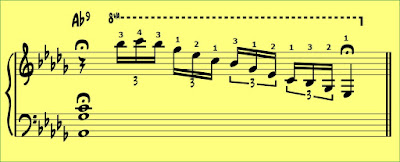and Bb9:
Eb9 is one of the trickier ones, needing the 4th finger as the pivot.
This one is not very practicable. But neither is the most obvious 5-3-2-1. The whole point of this series is to explore the Tatum 1-2-3 fingerings, fingerings to make for more even runs.
Even though I'm running through all twelve 9th chords fingerings here, some are just not used, even by Tatum. Some phrases work great in one key, terrible in another.
Eb9 is a bit of a conundrum to me at the moment. There are a few variations, such as:
Even though I'm running through all twelve 9th chords fingerings here, some are just not used, even by Tatum. Some phrases work great in one key, terrible in another.
Eb9 is a bit of a conundrum to me at the moment. There are a few variations, such as:
As I mentioned previously, in offering my fingerings for these chords, I'm wanting to share my explorations and discoveries, investigate how they can be integrated into contemporary jazz piano practice, and maybe extended into big band or orchestral concepts. It's all music, but I like investigating the 'nitty-gritty'. And investigating Tatum takes us back to the source, as it were, because a lot of Chopin and classical piano involves harp-like runs, and we know Tatum was thoroughly grounded in the 19th century romantic piano tradition.
In no sense am I suggesting these are definitive fingerings; rather, I encourage you to explore them yourself. I'm simply attempting to illustrate this Tatum concept, backed up by my own research—the idea being to make the fingerings of these harp-lie runs as even as possible without resorting to hand/finger contortions.
Thumb on Gb and C. Thumb on the tritone, the Devil's interval!
You should be getting the general idea that the hand makes a crab-like motion, alternating (pivot) 2-3:
Db9:
Thumb again on the tritone, this time F and B (Cb), alternating 2-3
As I mentioned previously, any dominant 9th chord is like a minor 6th or a half-diminished, so you get three for the price of one.
Continued in the next post.







No comments:
Post a Comment